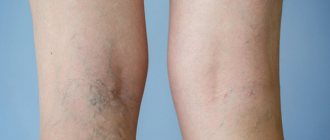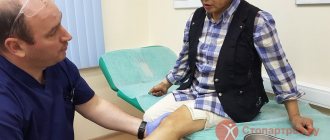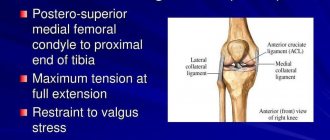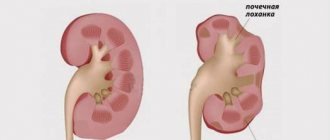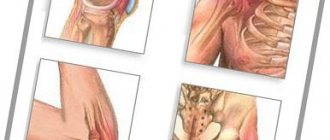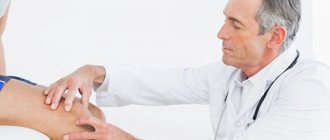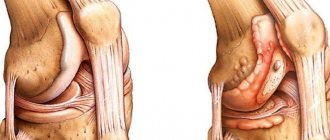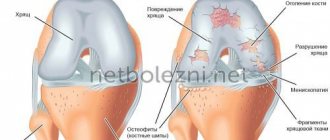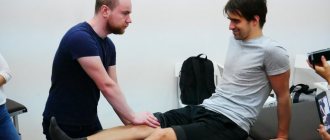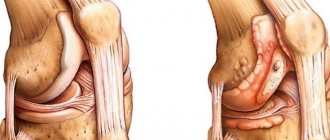Knee pain is one of the most common reasons for visiting an orthopedic doctor. Not only older people or athletes suffer from this problem; increasingly, a similar complaint appears in young people who do not engage in sports.
Knee pain is often the result of injury or overuse. Symptoms such as swelling, redness, numbness, pain and stiffness in the knee should be cause for concern.
Pain in the right knee can occur for a variety of reasons. These may be hereditary abnormalities in the development of the joint, increased load on the knee due to sports or professional activities, as well as excessive wear and tear on the joint structures due to injury or disease of the left leg.
Symptoms
Any injury or damage to the knee joint leads to pain and other associated symptoms. The most common signs and symptoms that may accompany knee pain are: redness, warmth, swelling and stiffness of the joint.
Swelling can occur in any part of the body due to the accumulation of fluid in the tissues. If this occurs in the knee area, the enlarged tissues compress the joint and it becomes stiff.
Infectious diseases of the joint often cause crepitus - a crunching sound in the knee. Joint instability can be caused by a fracture, ligament or tendon rupture, or progressive degenerative diseases.
Depending on the cause of your knee problems, the severity and location of the pain may vary.
When aching knee pain may occur: risk factors
Dull, aching pain in the front of the knee that gets worse with climbing stairs, bending, or squatting can be caused by patellofemoral pain syndrome.
In this case, the pain is due to swelling and irritation of the joint structures, including the ligaments and tendons that support the kneecap and the cartilage underneath it. Patellofemoral pain syndrome can occur for several reasons, including overuse of the joint, injury, and age-related wear and tear.
Other possible causes of aching pain in the right knee may include:
- Meniscus tear. Occurs when there is a sudden twisting movement or a strong blow to the knee.
- Infrapatellar bursitis. This is an inflammation of the bursae (small shock-absorbing sacs of fluid located under the kneecap). Both superficial and deep bursae can become inflamed and cause pain. Superficial infrapatellar bursitis occurs in people whose jobs require them to kneel, such as cleaners or construction workers. Deep infrapatellar bursitis can occur with systematic heavy loads (during sports or during professional activities).
- Baker's cyst. Also called popliteal cyst. This is a fluid-filled capsule that causes pressure and a dull, aching pain in the knee. The pain intensifies with full flexion or extension of the joint. The causes and risk factors for Baker's cyst are not known with certainty.
- Arthritis. Another possible cause of aching knee pain. Additional symptoms include swelling and stiffness of the joint. Age, obesity, and sports activities are the main risk factors for developing arthritis.
Treatment
Since there are many diseases that can manifest as knee pain, there is no single treatment strategy. In each case, it is developed individually, based solely on the nature of the pathological changes, their severity, the presence of concomitant pathologies, the individual characteristics of the patient, his age, etc.
For spinal pathologies that cause knee pain, treatment is carried out under the supervision of a neurologist. If they are the result of arthrosis or other pathologies of the knee, ankle joints, or feet, treatment is prescribed by an orthopedist.
When diagnosing pathologies of the spine or pelvic bones, patients, in addition to consulting a neurologist, may additionally be advised to visit an endocrinologist who will help solve the problem of excess weight.
All patients with spinal diseases, orthopedic pathologies, including arthrosis of the knee joints, are recommended for complex treatment, which may include:
- drug therapy;
- physiotherapy;
- exercise therapy;
- manual therapy.
Each measure is selected strictly individually in accordance with the diagnosis and the degree of neglect of pathological changes. And for grade 2-3 arthrosis of the knee joints, plasma lifting is often additionally prescribed.
Drug therapy
Drug treatment usually includes 2 areas: symptomatic and etiotropic therapy. The first is aimed at quickly improving the patient’s well-being, eliminating knee pain and other existing symptoms. The goal of the second is to directly influence the cause of the development of disorders and normalize the patient’s condition in the long term.
Therefore, in most cases, patients are prescribed a complex of medications:
- NSAIDs are symptomatic therapy that quickly relieves pain in the knee, lower back, and feet and has an anti-inflammatory effect.
- Corticosteroids are drugs with a powerful anti-inflammatory effect, indicated for severe inflammation and most often injected into the joint cavity. They are used in short courses.
- Chondroprotectors are products containing components used by cartilage tissue for regeneration. They are prescribed in long courses, usually lasting at least 2-3 months.
- Muscle relaxants are drugs prescribed for spasms in the muscles of the back and hips, which is often a reflex reaction of the body to pain impulses.
- Vitamin complexes are drugs indicated to improve the course of metabolic processes in the body, as well as the transmission of bioelectrical nerve impulses along the nerves.
Plasmolifting
Plasmolifting is an injection of plasma obtained from the patient’s own blood directly into the affected knee joint or the soft tissue around it. Due to the saturation of blood plasma with platelets, cytokines and growth factors, it promotes:
- stimulation of natural regeneration processes;
- restoration of the normal composition and volume of synovial fluid;
- activation of blood circulation and nutrition of joint cartilage;
- eliminating inflammation;
- pain reduction;
- restoration of normal range of motion in the affected joint;
- reducing treatment time by 2-3 times.
PRP therapy, as plasmolifting is also called, perfectly complements the therapy for arthrosis of the knee joint, so it is often included in the treatment regimen for this disease. It can also be used in the treatment of spinal osteochondrosis and injuries, complementing drug therapy, physiotherapy, exercise therapy and other treatment methods.
Physiotherapy
Various types of physical therapy treatments can be used to treat musculoskeletal disorders that cause knee pain. They increase the effectiveness of other treatment methods and have a positive effect on the affected area. Physiotherapy is always prescribed in courses of 7-15 procedures, which are selected individually. Most often they resort to help:
- magnetic therapy;
- ultrasound therapy;
- UHF;
- phonophoresis;
- electrophoresis;
- SMT therapy or amplipulse therapy;
- vibration massage.
Exercise therapy
Physical therapy plays an important role in the treatment of pathologies of joints of any location and the spine in particular. It allows you to dosely increase the range of movements, as well as stimulate blood circulation, which leads to increased nutrition of all structural elements of the knee joints and thereby promotes their regeneration.
But it is important to choose the optimal set of exercises that will be most useful in the current situation and will not cause harm. Patients may be advised to perform stretching exercises, which are especially important for spinal pathologies. Also, exercises are almost always prescribed to strengthen the muscular-ligamentous system. They contribute to the formation of a strong muscle frame, which will reduce the load on the affected joints and create favorable conditions for their recovery.
Exercise therapy classes are simple and accessible to people of any age, since an individually designed program ensures the creation of a precisely dosed load that has a positive effect on sore joints and eliminates exercises that can cause harm. But in order to master the methodology of each proposed exercise as accurately as possible, it is worth conducting the first classes under the supervision of a physical therapy instructor.
In the future, you can practice at home, outdoors or in any other suitable place, but every day. Systematicity is one of the basic rules for the success of physical therapy. Therefore, you need to add it to your list of daily tasks and devote the proper amount of time - 20-30 minutes is usually enough. During exercise, it is important to avoid sudden movements and haste, as this can cause pain and worsening of the condition.
Causes of pain
Pain in the right knee can be caused by a wide range of reasons, the main ones being the following.
Inflammatory and dystrophic diseases of the joint
The main ones from this group are arthritis (inflammatory diseases of the joints) and arthrosis (degenerative-dystrophic diseases of the joints).
Osteoarthritis and arthritis are often considered the same condition. This is wrong. Their main difference is that arthritis occurs as a result of inflammation, and arthrosis has a degenerative-dystrophic component. Its source is wear and tear of the cartilage tissue covering the heads of the femur and tibia.
The breakdown of cartilage causes bones to rub against each other, causing swelling, redness and pain. Although the diseases in these groups result in similar symptoms, they have different origins and treatment methods.
In arthritis, the synovium covering each joint becomes inflamed. Ultimately, the pathological process spreads to the bone and the cartilage covering it, causing swelling and pain.
With arthrosis, bones rub against each other, joints stop bending and straightening normally, and bone deformation occurs.
Knee ligament damage
The structure of the knee joint includes the external and internal collateral ligaments, as well as the anterior and posterior cruciate ligaments. They can stretch and tear.
A sprain occurs when several fibers that make up the ligament are torn. The rupture can be partial (several fibers are also torn, but more than in a sprain) or complete (the ligament is completely torn).
Most knee ligament injuries are sprains, not tears. Such injuries usually resolve on their own.
There are many different reasons that can lead to ligament injuries in the right knee:
- A direct blow to the knee and a bruise from the fall.
- Awkward movement beyond the knee's range of motion (often occurs during sports or vigorous physical activity).
The main symptoms of knee ligament damage are:
- A popping or clicking sound during injury. Usually occurs when the ligament is completely torn.
- Swelling of the knee. A ligament tear can cause bleeding from the damaged tissue. The knee swells. The degree of swelling depends on the severity of the injury. Minor sprains cause slight swelling that gradually appears over three hours. A complete rupture results in severe swelling, which occurs very quickly and is accompanied by severe pain.
- Knee pain. The degree of pain also depends on how severe the knee injury is.
- Sensitivity of the knee to touch. It can be minor if the injury is minor or severe if the ligament is completely torn.
Patella problems
Right knee pain can be caused by an injury or disease affecting the kneecap. The pain often gets worse when doing certain activities, such as climbing stairs or squatting for long periods of time.
There are several underlying patella-related problems that can cause knee pain:
- Chondromalacia patella (runner's knee). Occurs due to irritation of the cartilage at the bottom of the kneecap.
- Prepatellar bursitis. Causes swelling and inflammation in the lower part of the kneecap. Usually occurs in people who are forced to kneel for a long time (cleaners, gardeners).
- Subluxation of the kneecap. Also known as patella instability. In people who suffer from this painful knee condition, the kneecap extends beyond its normal location.
- Dislocation of the kneecap. Occurs when the kneecap moves completely out of the femoral groove (trochlear groove). This injury is accompanied by severe pain.
- Patellar tendon rupture. This is a serious injury that occurs when the tendon that connects the cup to the shin is completely torn. Recovery takes at least four to seven months.
Meniscus injury
A torn meniscus is one of the most common knee injuries. Any movement that involves extreme bending or rotation of the knee, especially on the supporting leg, can cause a meniscus injury.
A rupture may be accompanied by the following symptoms:
- Swelling and redness of the knee
- Pain that worsens with rotational movements of the knee
- Difficulty fully straightening the knee
- Feeling of knee instability
The risk of meniscal tears is high in athletes, especially those who play contact sports such as basketball or soccer. Age-related wear and tear on knee joint structures and obesity are other risk factors for meniscal damage.
Causes
Knee pain can accompany a variety of diseases, ranging from arthrosis of the knee joints to pathologies of the lumbar, sacral spine, and pelvic bones. Chondropathy, arthritis, neuritis and other similar diseases can also cause discomfort or even acute pain in the knees.
The obvious cause of the development of pain syndrome is various types of injuries from bruises, dislocations, to ligament ruptures, meniscal injuries or intra-articular fractures. But in such situations, the pain is almost always acute and appears at the moment of a blow, fall or other traumatic factors. Therefore, in such cases, victims need to contact a traumatologist to treat the consequences of the injury.
Thus, pain in the knee is always a sign of a pathological process that affects the cartilaginous, bone or soft tissue structures of the knee itself, or damage to the nerve that innervates it. Let's look at the main reasons for their appearance.
Arthrosis of the knee joints or gonarthrosis
Arthrosis, osteoarthritis of the knee joint or gonarthrosis is one of the most common causes of knee pain. This disease is characterized by the occurrence of degenerative-dystrophic processes in the cartilaginous structures of the joint, which becomes a consequence of disruption of metabolic processes, the action of traumatic factors in the past, etc. Very often, gonarthrosis is diagnosed in middle-aged and elderly people, athletes and people engaged in heavy physical activities. labor.
This disease has a chronic course, tends to progress slowly and ultimately lead to severe limitation of joint mobility, impairment of the supporting function of the limb (usually both), and pain. Initially, they are dull, aching, pulling in nature and appear during movements, accompanied by a crunching sensation in the knee, especially while climbing stairs. But if left untreated, the cartilage of the knee joints continues to progressively wear out, which leads to increased pain and its presence even at rest. Subsequently, destruction of the articular surfaces occurs, which further aggravates the situation and can even cause disability.
A typical feature of arthrosis of the knee joints is the presence of initial pain, to eliminate which patients need to “disperse”. Thanks to this, an improvement in the condition is observed within 15-30 minutes.
Gonarthrosis is often complicated by the addition of inflammatory processes that can affect the synovial bursa, ligaments and tendons. This leads to a sharp increase in pain, acquiring a bursting character, swelling of the soft tissues and a local increase in temperature.
Diseases of the spine and asymmetry of the pelvic bones as a cause of knee pain
At first glance, there is no connection between the lumbar spine and the knees. But in reality this is not the case. They are closely interconnected by the sciatic nerve (nervus ischiadicus), which is the main nerve of the leg. It originates in the spine and is formed simultaneously by fibers extending from the spinal cord through natural openings in the vertebrae of the nerves:
- L4;
- L5;
- S1;
- S2;
- S3.
These nerves pass through the vertebrae of the same name, uniting at the level of the sacrum into a nerve plexus. From it the sciatic nerve extends along the dorsum of each leg and innervates the knee. In this case, this nerve is responsible for its sensitive (sensory) and motor (motor) functions. Therefore, disturbances at any point in its passage, in particular at the level of the lumbar region, can provoke the appearance of pain in the knee. Most often this is due to the development of:
- Osteochondrosis, protrusions and intervertebral hernias. These diseases are based on degenerative-dystrophic changes in the intervertebral discs located between almost all vertebrae. They are characterized by a systematic decrease in the height of the disc and its dehydration, which leads to a decrease in the elasticity of its structures and an increased risk of their rupture under load. As a result, the vertebrae move closer together, which can lead to compression of the nerve roots passing through them. If such changes occur in the lumbar region, compression of the fibers that form the sciatic nerve is possible and, accordingly, the appearance of pain in the knee. But more often, this symptom occurs when osteochondrosis is complicated by the formation of a protrusion (bulging) of the intervertebral disc or its herniation (rupture of the outer shell of the disc), since the protruding areas can strongly compress the spinal roots directly in the spinal canal and provoke the appearance of severe neurological complications, including pain in the knee.
- Spondylosis. This is a disease that most often develops against the background of osteochondrosis and is chronic. When it occurs, there is an overgrowth of the surfaces of the vertebral bodies adjacent to the intervertebral discs and the formation of bone protrusions (osteophytes) on them. In severe cases, adjacent vertebrae can fuse together, which leads to their immobilization and severe compression of the nerves passing through them.
- Spondylolisthesis. This term refers to a pathology of the spine in which the overlying vertebra is displaced in relation to the one located below it. Most often, it is the lumbar region that is affected, which leads to pinching of the nerves that form the sciatic nerve.
Signs by which one can suspect the cause of the development of knee pain due to the occurrence of pathologies of the lumbar spine may include the presence of additionally:
- nagging, aching, acute pain in the lower back;
- muscle tension, hamstrings, quadriceps femoris muscle, which occupies the entire front surface of the thigh and partially the outer side;
- pain and stiffness in the hips;
- diffuse pain in the legs;
- pain in the upper thighs.
In each individual case, the set, nature and severity of symptoms will be different. This largely depends on the individual characteristics of the body and the degree of nerve compression.
Damage to the sciatic nerve may be directly indicated (symptoms can be observed in only one limb or in both at once):
- pain in the knees, hips and lower back;
- spasms of the muscles of the back and legs;
- burning along the back of the leg;
- loss of control of bladder and bowel functions.
When the functioning of the sciatic nerve is impaired, there is often a feeling of instability in the knees and their compression. As a result, the patient complains that he cannot fully rely on his legs.
Asymmetry of the sacrum and pelvic bones can also provoke the appearance of pain in the knee joint. It occurs as a result of a difference in the length of the lower extremities, which may be a consequence of congenital features or curvature of the pelvis, including due to scoliosis. This leads to overload of one of the legs and faster wear of the cartilage of the knee joint, resulting in arthrosis.
The abdominal muscles, which attach to the pubic bone, are responsible for ensuring the stability of the pelvic bones. When they are weakened as a result of excess weight, a sedentary lifestyle, or other factors, the muscles of the back of the thigh are overloaded. This in turn provokes overload of the knee joint.
Pathologies of the feet and ankle joints
Ankle joints, like knee joints, can be affected by arthrosis. It is often diagnosed in athletes, especially ballet dancers, gymnasts, as well as in older people. This leads to disruption of the biomechanics of movements, which increases the load on the knee joint and contributes to its faster wear. In such situations, a person will be bothered by pain not only in the knee, but also in the ankle, which significantly affects the gait due to limited movements.
Foot pathologies, in particular flat feet and hallux valgus, can also provoke increased stress on the knees and cause pain in them. These orthopedic pathologies are very common today and in most cases begin to form in childhood and worsen in adulthood. Hallux valgus is characterized by a violation of the axis of the ankle joint as a result of the foot falling inward. This is associated with increased fatigue of the legs and pain in them, but can subsequently lead to pain in the knees.
Preventing pain in the right knee
To avoid pain in the right knee, it is necessary to limit the load on the leg. For athletes and people engaged in work activities that primarily involve the right knee, supporting orthoses can be selected. Try not to kneel on a hard surface. In addition, you can follow general recommendations:
- Maintain a healthy weight. Excess weight increases the risk of developing arthrosis, so your body weight should be appropriate for your height and age. A healthy weight reduces stress on your knees and reduces the likelihood of joint injuries.
- Wear comfortable shoes. This helps maintain even load on the joints and avoid injury.
- Warm up before physical activity. Don't forget to warm up your muscles before training. Stretching the muscles in the front and back of your thighs reduces tension in the tendons and ultimately reduces stress on your knees.
- Choose the right exercise. When working out at the gym, choose rowing machines or cross-country skis. Such exercises train the muscles well and do not damage the knees.
- Swim or walk. When exercising outside the gym, give preference to swimming or walking.
- Strengthen your muscles. Strengthen the leg muscles that support the knee joint. Be sure to consult an expert if you are planning to engage in weight lifting exercises.
- Maintain adequate physical activity. Decreased physical activity leads to weakened muscles and an increased risk of injury.
